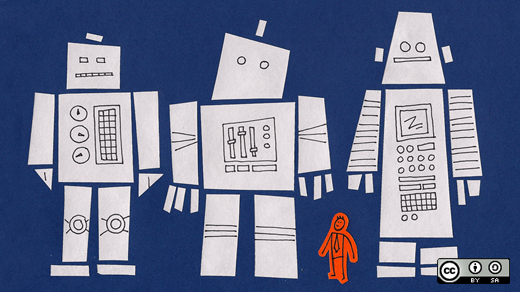We are quickly entering a world in which you may spend more of your day communicating with robots than with humans.
Don't believe me? Ask yourself how many times you've used an automated checkout machine or ATM in lieu of a human, called the 1-800 number for a customer service need and been greeted by a machine, asked Google or Alexa what temperature to roast your brussels sprouts at, or interfaced with a website that gave you a personalized recommendation.
With artificial intelligence, machine learning, and automation now becoming a part of nearly every service we interact with, it's no surprise that developers are interested in learning more about how they can keep ahead of the curve.
One great way to get started with automated constructed conversations is by building a Twitter bot. The artificial limitation of 140 characters will keep you focused on something you can accomplish quickly and easily. No, you're not going to build a personal butler that will automate your life, but you might come up with something fun and learn something in the process.
If you're looking to get started, this guide from Raspberry Pi Foundation Community Manager Ben Nuttal on making your own Twitter bot with Python and Raspberry Pi will tell you everything you need.
But if you're just looking for some inspiration, we've got you covered as well. Here are some of my favorite open source Twitter bots (including a couple suggested by Opensource.com moderator VM Brasseur). Many Twitter bots rely on an open source project called Tracery, which you can download and install yourself, or host your own on Cheap Bots, Done Quick. Some are a little more advanced, and for these, you can find the complete source in the link provided.
@everyonesai
This fun little bot, @everyonesai, mixes up the Google Quickdraw dataset (itself under a CC BY-SA 4.0 license) with faces and text. The result is somewhat of a silly comic. The Tracery source code can be found here.
— everyones a AI (@everyonesai) August 7, 2017
@fewerror
Are you a badge-carrying member of the grammar police? Then you'll love @fewerror, a bot that crawls Twitter looking for people who perhaps meant "fewer" when they said "less" instead. Full source is available under an MIT license on GitHub.
@RichardDawkins I think you mean “fewer hasty”.
— Fewer Errors (@fewerror) January 27, 2014
@sunnyday4pm
Art bots are among my favorites, and if you appreciate the art of random geometric shapes, you'll appreciate @sunnyday4pm. You can grab the source code off of GitHub, and read the backstory on Medium.
Melting by the warm breeze! ? №387 pic.twitter.com/CklVx6BPiw
— Sunny day, 4 PM (@sunnyday4pm) August 9, 2017
@le_gen_da_ry
This bot is legendary, and it has the Twitter handle (@le_gen_da_ry) to prove it. Follow it for regular humor in your Twitter stream, or check out the source code on Git ...wait for it... Hub.
It's going to be CLOUD- ...wait for it... -COVERED!
— Barney Stinson (@le_gen_da_ry) August 9, 2017
@catsnacks
If you, like me, believe the internet needs more cat pictures, then @catsnacks is worth a follow. To learn how to auto-generate your own smiling cat faces that look much like the kitties from Neko Atsume, check out the GitHub repository.
— Cat Snacks (@catsnacks) August 9, 2017
@neuralgae
The DeepDream neural network image generator has created quite a few inspired projects, including @neuralgae, a surrealist painter and poet bringing its creations to your feed. The source, in Python, can be found here.
mud turtle bottom-dwelling freshwater dace-like game in baboon large penguin on a spiny proboscis monkey Borneo pic.twitter.com/HhtImq4Is0
— neuralgae (@neuralgae) August 9, 2017
@snozzbot
For any fan of Willy Wonka, the reference here will be obvious. Follow @snozzbot for an hourly dose of things that taste like, well, other things, or just check out the source code here.
The otterberries taste like otterberries!
— Willy Wonka (@snozzbot) August 9, 2017
That rounds out this list, but this is by no means an exhaustive collection. To find more, a great place to start is Botwiki, where you can filter by type of bot, network it operates on, whether it's open source, and more. GitHub has hundreds of additional examples that may be worth checking out.
Which open source Twitter bots do you follow? Have you ever built one yourself? Let us know in the comments below.







Comments are closed.